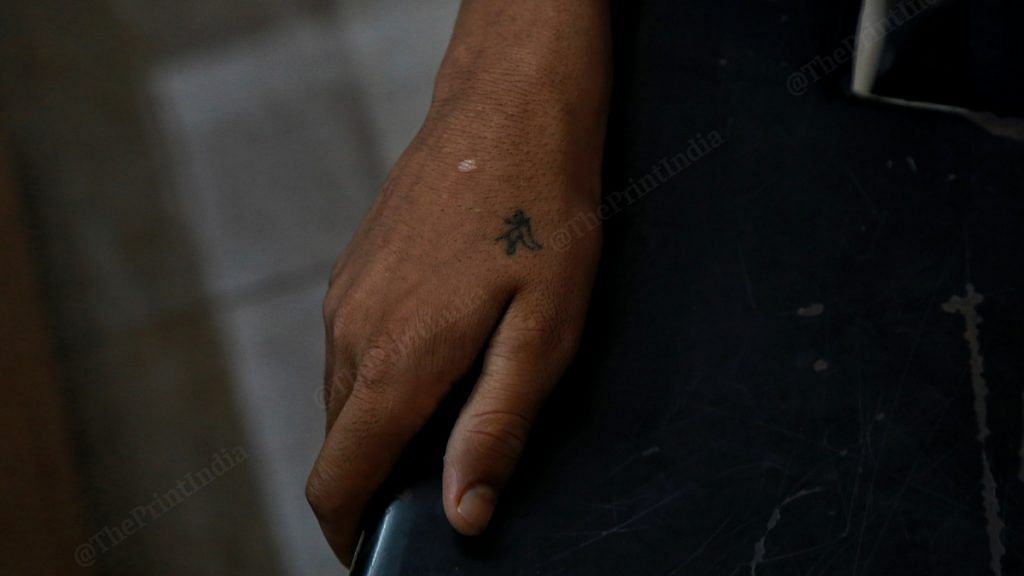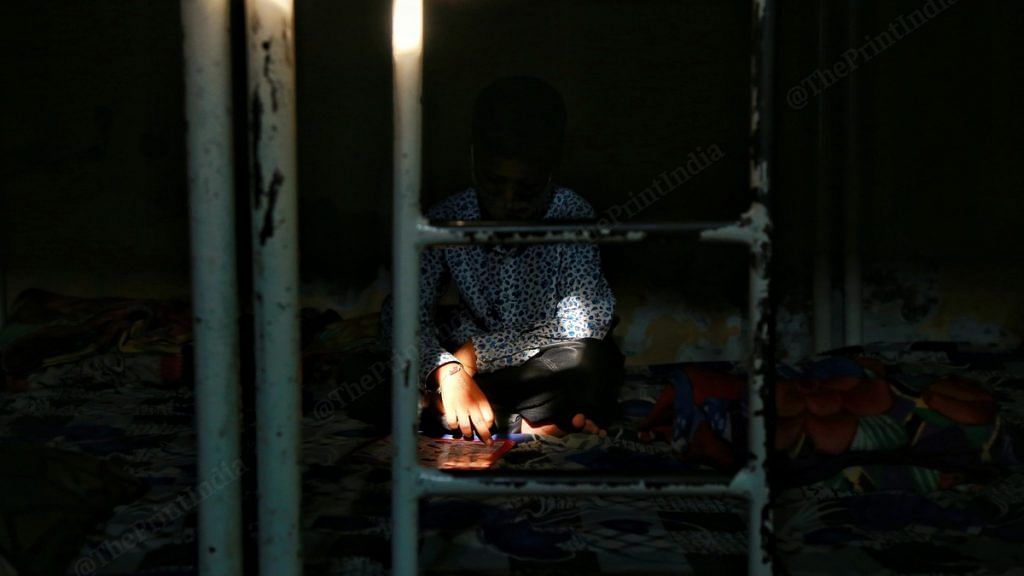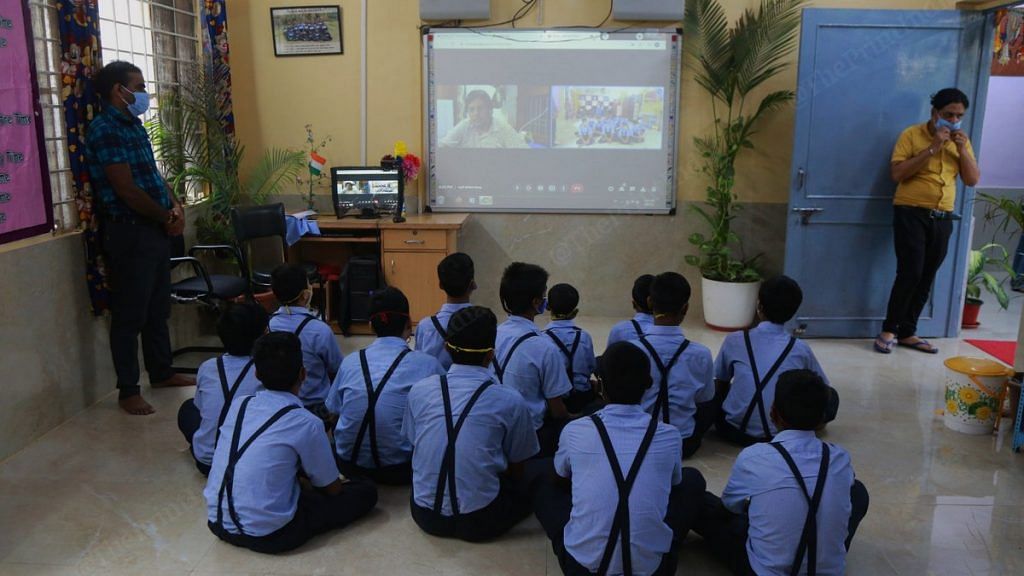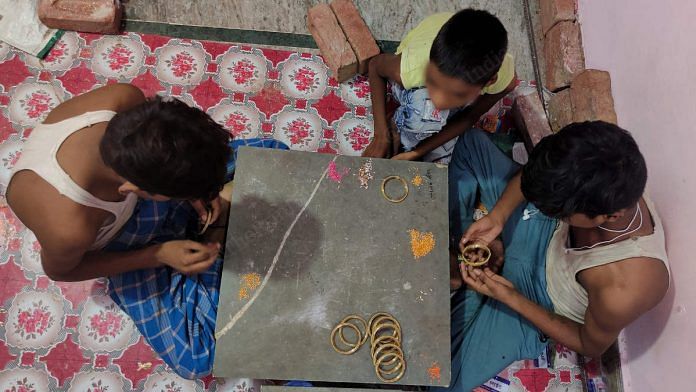Jaipur: Two rooms, each 4 feet by 4 feet, with no windows, fans that don’t work, and paan stains on the walls. Nineteen children sit there, on the floor, their nimble fingers sticking bits of glitter and glass on lac bangles. Each child sits bent over the work, without masks, without observing social distancing protocols, making 400-500 bangles a day. Each bangle fetches between Rs 10 and Rs 50 in markets across Rajasthan. The children work 16-18 hours a day, making a mere Rs 50, well below the minimum wage of Rs 252 per day in Rajasthan.
Children who should be in school are working in Dickensian conditions across Rajasthan, a majority in bangle factories, and others in roadside dhabas, tyre shops and saree printing workshops, trying to support families that have either lost work during the Covid-19 pandemic or seen deaths in the family. Their necks and shoulders hunched for long periods of time, their eyes squinting against the sunlight, and their bodies wracked by malnutrition, they are the invisible victims of Covid.

According to data from Census 2011, the number of child labourers in India is 10.1 million, of which 5.6 million are boys and 4.5 million are girls. The next census is due in 2021, but surveys conducted by child rights organisations suggest there has been a sharp surge in child labour across the country post Covid due to mass abject poverty.
The International Labour Organisation (ILO) and UNICEF have also warned that in India, the closure of schools and the economic crisis faced by the vulnerable families, triggered by the pandemic, are likely drivers pushing children into poverty, and thus, putting India at risk of growing child labour post-Covid, with migrants mostly from low-income states like Bihar, UP, West Bengal, Chhattisgarh, and Jharkhand.
Also read: 1 in 10 children now in child labour. And it’s rising for first time in 20 yrs
Beaten & denied food, children fall ill
Five children have died in Rajasthan between July 2020 and January 2021 due to abysmal working conditions and malnutrition. Four of the five children were from Bihar, aged between 12 and 15, and worked in bangle factories. The charge sheets in all five cases, accessed by ThePrint, detail the conditions under which the children worked. One of the charge sheets has a statement of a 12-year-old which reads, “Our maalik (owner) would force us to make lac bangles in the basement for 18-19 hours. He would not give us food on time and beat us.”
All the five bangle manufacturers who employed these children have been charged under various sections of the Indian Penal Code, including 304 (culpable homicide not amounting to murder), along with relevant sections of The Juvenile Justice (Care and Protection of Children) Act, 2015, and The Child Labour (Prohibition and Regulation) Act, 1986. But the deaths have not prevented the rise of child labour in Rajasthan. Officials say the state has seen a sharp surge, despite strict lockdown for more than four months last year.

“I can’t sleep at night due to severe pain in neck and eyes. The doctor says I’m suffering from some disease,” said a seven-year-old boy who was working in a lac bangle warehouse in Jaipur’s Shastri Nagar for Rs 50 a day. His parents sent him to Jaipur to earn for the family in February 2021 when schools closed down. When he was rescued in July this year by a team comprising members of the Anti-Human Trafficking Unit of the Jaipur police, the labour department of the Rajasthan government, and volunteers from Nobel Laureate Kailash Satyarthi’s NGO, Bachpan Bachao Andolan, he was suffering from malnutrition and acute deficiency of Vitamin D.
Dr N.L. Dissania from Sawai Man Singh Hospital, who conducted a medical examination of the rescued child labourers, told ThePrint, “These children suffer from a number of illnesses. They have to keep their necks down for long hours to work and that leads to spondylosis, which is very rare at their age, but may become fatal.”
All the child labourers examined in the last two years suffered from malnutrition. “They had a severe deficiency of Vitamin D due to lack of sunlight, which puts them at risk of developing rickets,” added Dr Dissania.
Around 1,500 child labourers were rescued from across Rajasthan in 2020, compared to 1,700 the year before. But according to an official of the Anti-Human Trafficking Unit, the count on paper does not reflect the actual situation, because they could not conduct rescue operations during the lockdown. “Many children worked inside locked factories but they could not reach out to anyone or be rescued,” the official said.

Vijaya Sharma, member, Child Welfare Committee, concurred. “Around 170 shelter homes and child welfare institutions across the state are currently packed with more than 4,000 children from different states. In the last five years, the number never crossed 2,000. And this is the situation after many children could not be rescued last year,” Sharma said.
“The most unfortunate bit is that 80-90 per cent of child labourers being rescued post-Covid are school dropouts. Before Covid, the children we rescue had never been to school, but the trend has changed now,” she added.
Deshraj Singh, a child rights activist from Bachpan Bachaao Andolan, told ThePrint: “According to our sources, more than 5,000 child labourers have come into the state after Covid. But even after knowing the reality, the police delay the rescue operations for logistical reasons and by then, the owners are alerted and clear their factories.”
Why child labour & trafficking have increased in pandemic
Brijlal Meena, chairperson of the Child Welfare Committee of the Rajasthan government, said there definitely has been a surge in child labour and trafficking post-Covid.
“More than 80 per cent of the children brought to Rajasthan came willingly, but they didn’t know that they would be exploited like this. Abject poverty and the need to survive brings them thousands of kilometres away from their houses to work in inhuman conditions,” Meena told ThePrint.
The children are not just a source of cheap labour, but also at a lower risk of getting Covid. They have nimble fingers and feet, so they can be easily crammed inside small spaces, and most importantly, they cannot protest against the treatment meted out to them by the factory owners.
“We do whatever we can for the children, from giving them medical aid to giving them education in shelter homes for two months, but unfortunately, many are sent back again to work,” Meena added.
The children and their families say they have no option.
“My mother used to work on construction sites till last year, but after Covid, no one gives her work. My father is crippled. Schools were also shut so I came to work. If I don’t work, my mother will sell my sister,” said an eight-year-old boy from Bihar’s Hindon, who came to Jodhpur last November to work in a highway dhaba.
When ThePrint reached the family for comment, the boy’s mother said: “Come and see how we’re living and then perhaps you will understand what we’re going through every day. My children haven’t eaten properly for the last two years. I’m not getting any work. My husband lost both his legs in an accident in 2019. We had to take a loan for his treatment. Now they threaten us that if we don’t pay back, they will take away my daughter. You think I like sending my son away to work? But what other option do I have?”
Also read: A peek into Jharkhand’s mica mines where child labour & illegal mining are no secret






